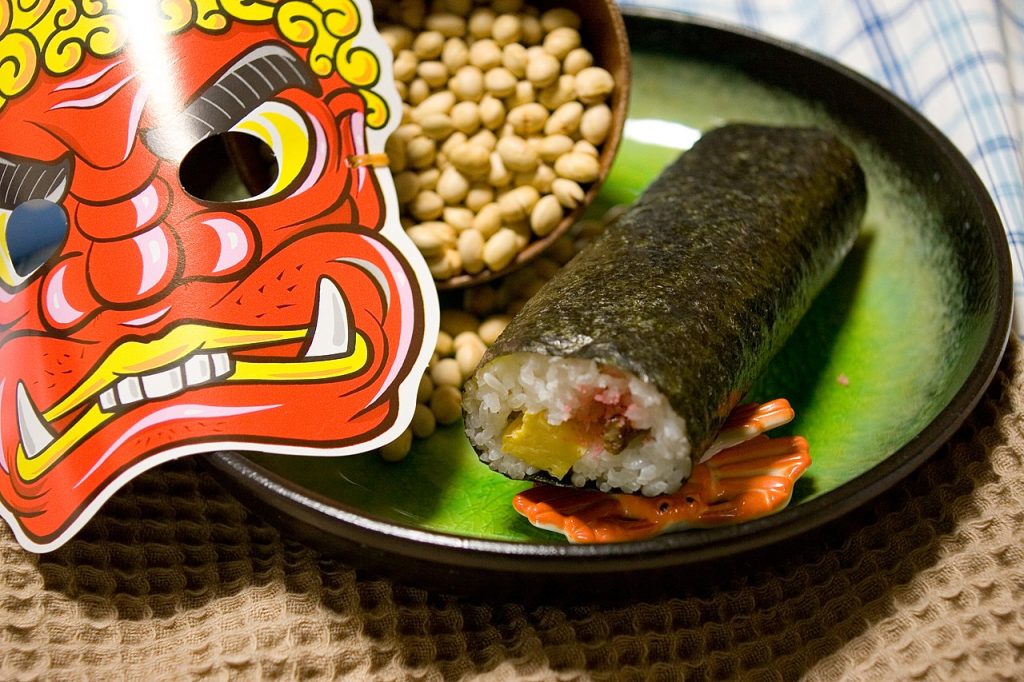Setsubun, or “That Bean-Throwing Festival,” is a beloved Japanese tradition that heralds the arrival of spring. Celebrated annually on February 3rd as part of the Spring Festival, Setsubun holds a special place in Japanese culture, marking a sort of New Year’s Eve due to its association with the Lunar New Year. At the heart of Setsubun is a unique and vibrant ritual known as “mamemaki,” which translates to “bean throwing.” This custom is performed to cleanse away the previous year’s evils and drive away malevolent spirits, making way for good fortune in the year to come.
The Mamemaki Ritual
The central figure in the Mamemaki ritual is the “toshiotoko,” a male born in the corresponding year of the Chinese zodiac or the male head of the household. Roasted soybeans are the stars of this tradition, as they are thrown either out the door or at a family member wearing an “Oni” (demon) mask. As the beans fly through the air, people shout, “Demons out! Luck in!” (Oni wa soto! Fuku wa uchi!) emphasizes driving away negativity and welcoming positivity.
Though this practice is no longer as common in households as it once was, many people still participate in Setsubun by attending a shrine or temple’s spring festival. At these events, a similar bean-throwing ceremony occurs, and attendees join in the fun, hoping to catch a handful of roasted soybeans that will bring good luck.
Eating Roasted Soybeans for Luck
Eating roasted soybeans is an essential part of Setsubun customs. It is customary to consume one roasted soybean for each year of one’s life, and in some regions, an extra bean is eaten to bring good luck for the upcoming year. This act symbolically purifies the home and is believed to drive away evil spirits that may bring misfortune and bad health.
Setsubun Celebrations at Home
Setsubun is usually celebrated at home with family. If you don’t feel like going to a temple to observe Setsubun, here is how you can do it at home.
- Gather the Essentials:
Make sure to have roasted soybeans (Fuku Mame) for the mamemaki ritual. You can either buy them from a local store or prepare them at home by roasting dried soybeans in a pan until they turn slightly brown. Oni masks are optional, but they add a fun element to the celebration. You can have family members wear Oni masks to represent the evil spirits. Lastly, prepare or buy eho-maki, a particular type of sushi roll, for the lucky direction ritual. - Purify and Prepare:
Before the ceremony, clean and purify your home by tidying up and lighting incense or candles to create a serene atmosphere. - Mamemaki (Bean Throwing):
Designate one family member as the “toshiotoko” (usually the eldest male or the head of the household) to be the “oni,’ or ogre. Gather the rest of the family in a room with a bowl of roasted soybeans. As the family throws the beans, they shout, “Oni wa soto! Fuku wa uchi!” to drive away the demons and welcome good luck. Remember to throw an odd number of beans (e.g., 7 or 3 times) for good luck. - Lucky Direction Ritual:
Determine the lucky direction for the year based on the Chinese zodiac. While facing that direction, each family member eats a whole eho-maki sushi roll in silence, making a wish for the year ahead. It’s essential not to speak during this ritual. - Enjoy a Festive Meal:
After the rituals, enjoy a meal together with your family. You can have a special Setsubun-themed meal with traditional Japanese dishes like sushi, tempura, and soup. - Share Good Fortune:
Share the remaining roasted soybeans with family members and friends as a symbol of spreading good fortune. - Decorate Your Home:
Consider decorating your home with seasonal flowers, cherry blossoms, or other spring-themed items to enhance the festive atmosphere. - Reflect and Make Wishes:
As a family, reflect on the past year and discuss your hopes and wishes for the coming year. This is a very meaningful part of the celebration.
Setsubun Celebrations at Temples and Shrines
Across Japan, Buddhist temples and Shinto shrines hold lively celebrations for Setsubun. Priests and guests participate in bean-throwing, tossing roasted soybeans (some wrapped in gold or silver foil), small envelopes with money, sweets, candies, and other prizes to the crowd. In larger shrines, the festivities often include appearances by celebrities and sumo wrestlers, making these events a national spectacle, even televised.
Osu Kannon Temple Setsubun Festival
One of Nagoya’s most famous and exciting Setsubun celebrations takes place at Osu Kannon Temple on February 2nd. The highlight of this festival is the departure of a ship meant to bring good fortune from Sakae, making its way to Osu Kannon. What sets this celebration apart is the sight of the ship being pulled through the Osu Shopping Arcade, creating an exhilarating atmosphere for all in attendance. The festival is open to the public and a must-see!
Osu Kannon Temple
460-0011 Aichi Prefecture, Nagoya, Naka Ward, Osu, 2 Chome−21−47 (map)
052-231-6525
Narita Manpukuin Temple Setsubun Festival
While not as well-known as Osu Kannon Temple’s festival, the Setsubun celebration at Narita Manpukuin Temple is impressive and worth experiencing. This event also takes place on February 3rd and offers visitors a chance to partake in the age-old traditions of Setsubun. The Setsubun Bean Sowing Ceremony runs from 2 a.m. to 10:6 p.m., where participants can sow beans and pray for good luck and exorcism. This mountain shrine has been a model for shrines and temples in the region, drawing many visitors seeking blessings.
Narita Manpukuin Temple
460-0008Aichi Prefecture, Nagoya, Naka Ward, Sakae, 5 Chome-26-24 (map)
052-241-7670
sakura_chihaya+, CC BY-SA 2.0, via Wikimedia Commons
